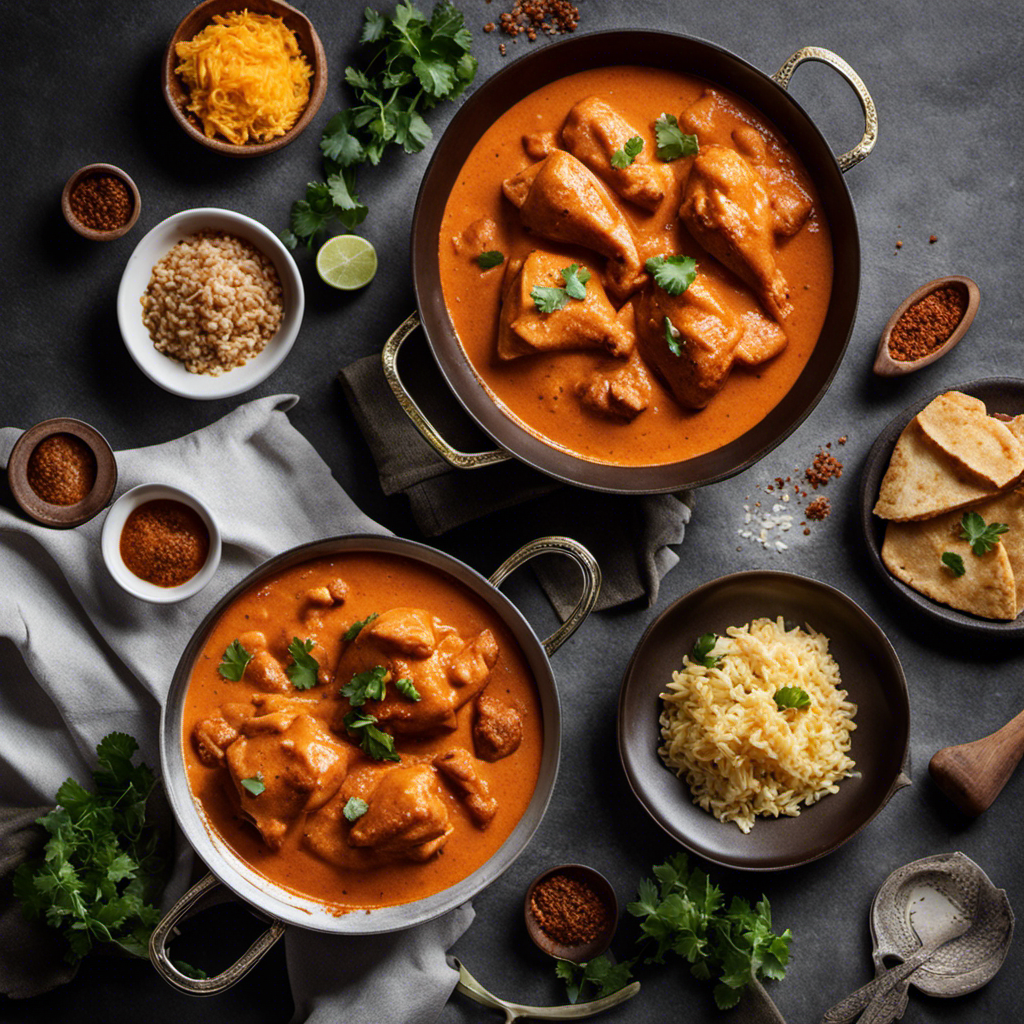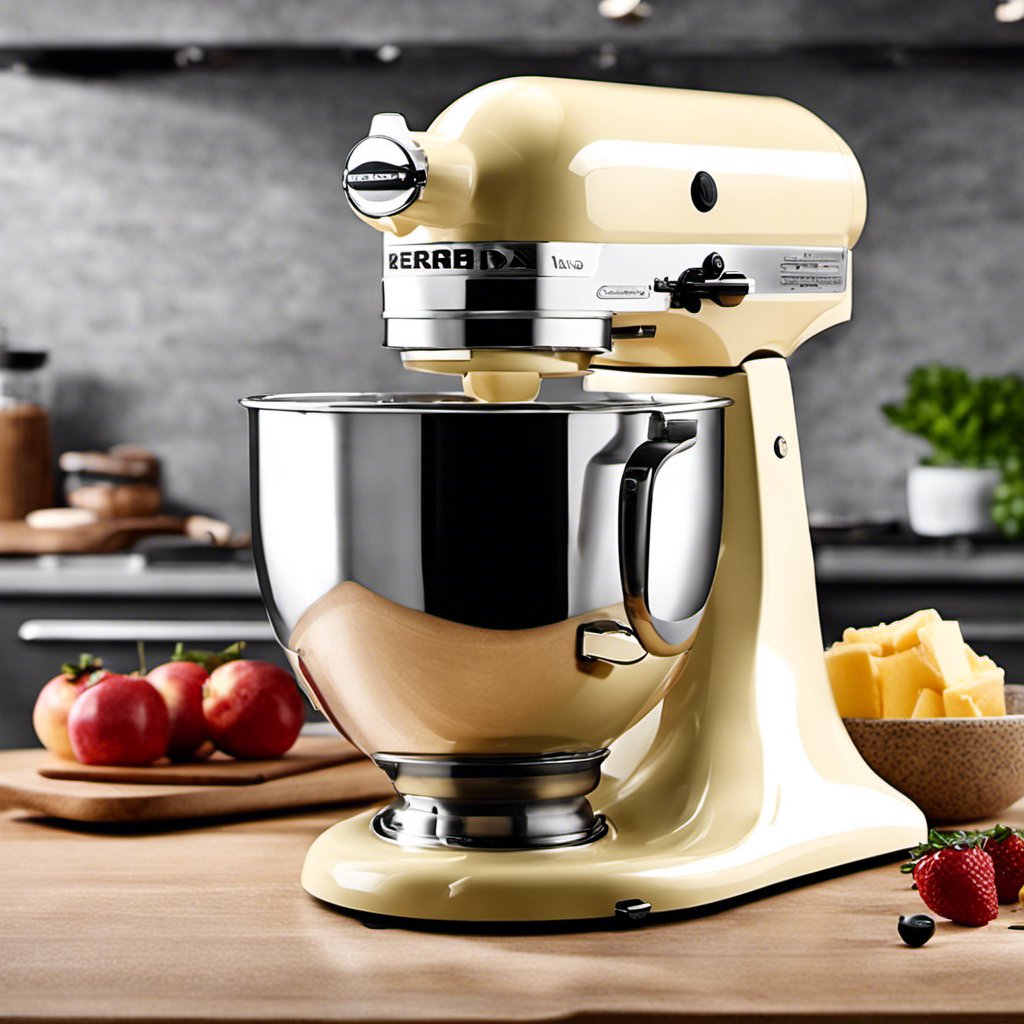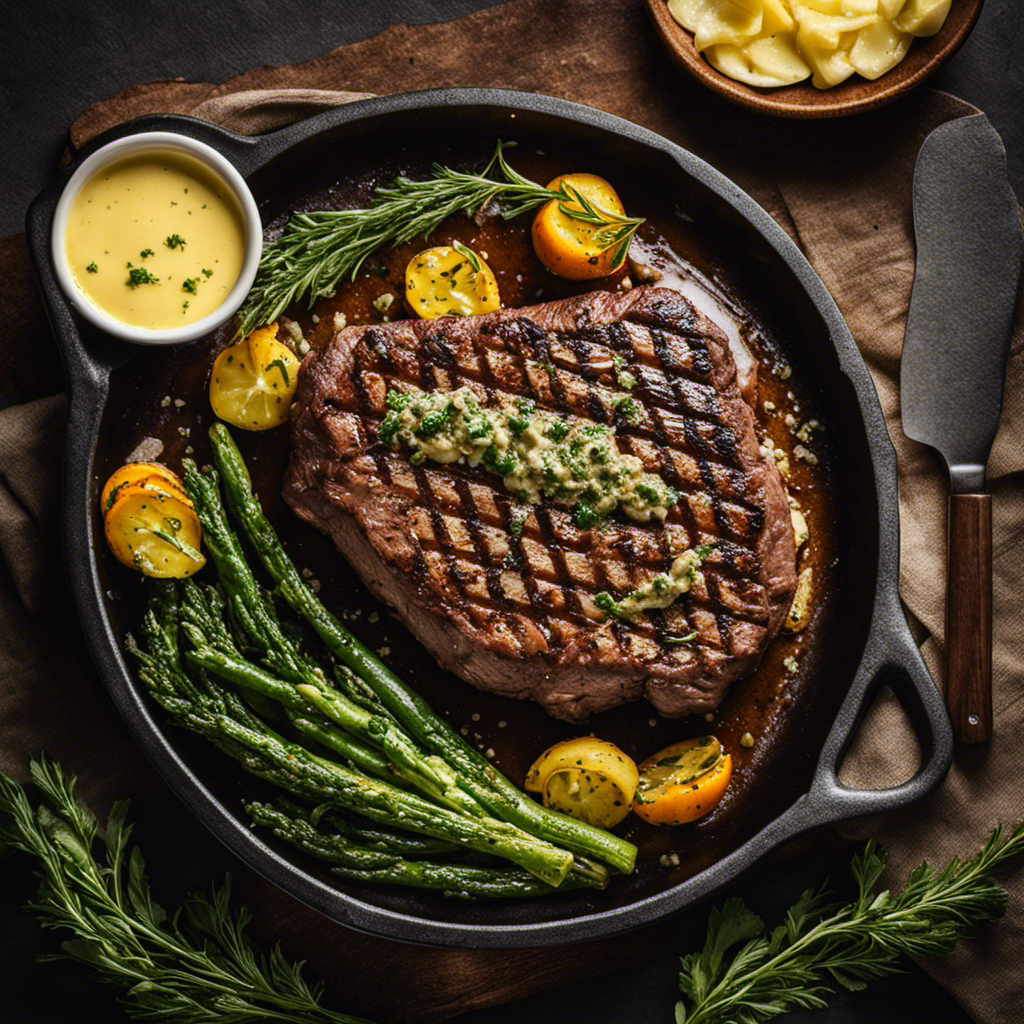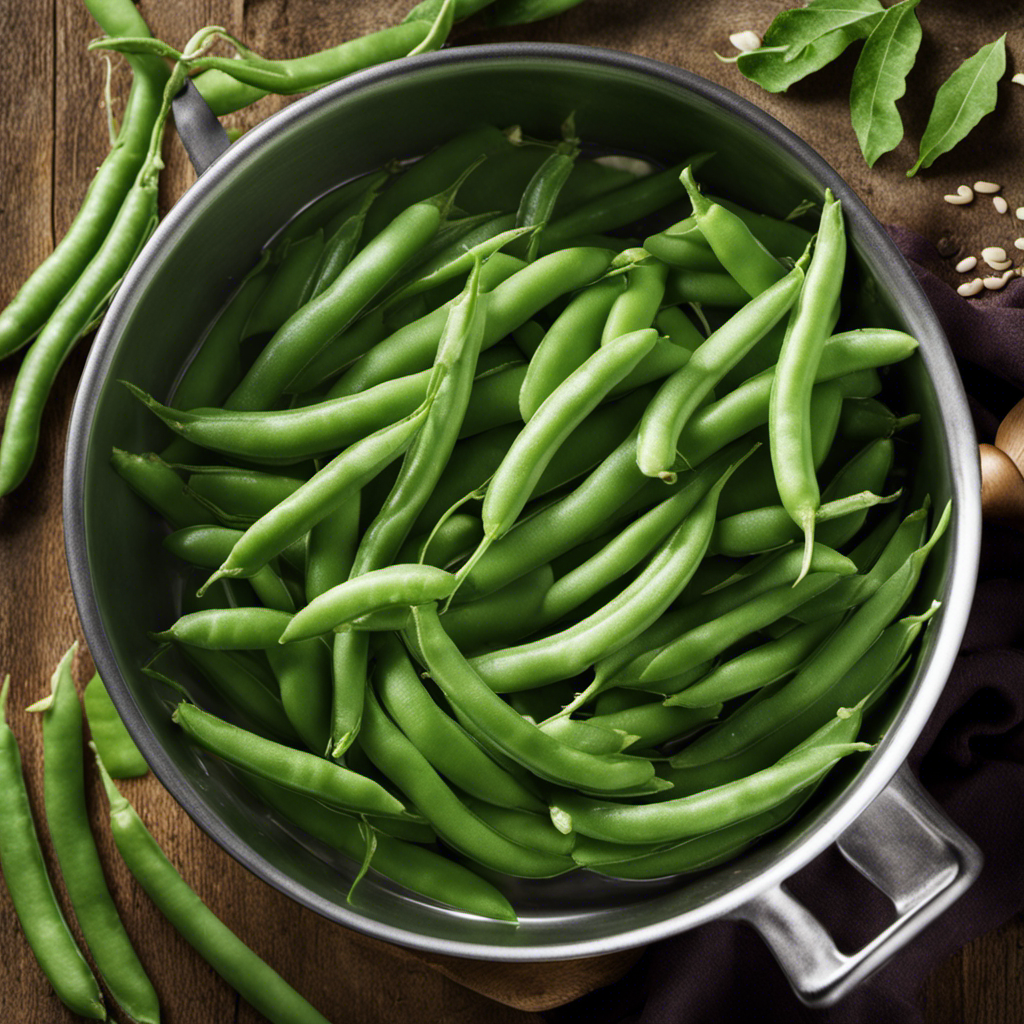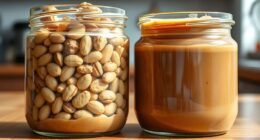I have always loved Indian food, but there is one dish that really excites my taste buds – butter chicken.
Did you know that it’s estimated that over 100 million servings of butter chicken are consumed worldwide each year? With its rich and velvety tomato-based sauce, tender marinated chicken, and fragrant blend of spices, butter chicken is a flavor explosion like no other.
In this article, I will delve into the intricate flavor profile, aroma, texture, spiciness level, creaminess, balance of flavors, tanginess, and overall experience of indulging in this delectable dish.
Get ready to embark on a culinary adventure!
Key Takeaways
- Rich and creamy flavor enhanced by spices and ghee
- Burst of flavor in every spoonful
- Creamy consistency that coats every piece of chicken
- Harmonious blend of spices with a moderate spiciness level
The Flavor Profile of Butter Chicken
Butter chicken has a rich and creamy flavor that is enhanced by the combination of spices and the use of ghee. The richness of butter chicken is truly unparalleled.
The tender pieces of chicken are marinated in a yogurt and spice blend, then cooked in a tomato-based gravy that is infused with the aromatic flavors of cumin, coriander, and fenugreek. The addition of butter and cream adds a velvety smoothness to the dish, making every bite incredibly indulgent.
The depth of flavors in butter chicken is mesmerizing. The spices blend together harmoniously, creating a complex taste that is both savory and slightly tangy. Each spoonful is a burst of flavor, leaving you craving for more.
As you savor the richness and depth of butter chicken, the aroma of the dish fills the room, enticing your senses and preparing you for the culinary delight that awaits.
The Aroma of Butter Chicken
The aroma of butter chicken is so enticing that it makes my mouth water. As soon as the fragrant spices hit my nose, I am transported to a world of culinary delight. The richness of butter chicken is unparalleled, with its creamy tomato sauce and tender, succulent pieces of chicken. Each bite is a burst of flavor, a perfect balance of spices and creaminess. The indulgence of butter chicken is undeniable, as it melts in my mouth and fills me with pure satisfaction. It is a dish that is meant to be savored and enjoyed, a true indulgence for the senses. With every bite, I am reminded of the beauty of Indian cuisine and the artistry that goes into creating such a delicious and aromatic dish.
| Flavor | Description |
|---|---|
| Creamy | The sauce is velvety smooth, coating each piece of chicken with a luxurious texture. |
| Spicy | The spices add a kick of heat that lingers on the palate, enhancing the overall flavor profile. |
| Tangy | The tomato base provides a tangy undertone that cuts through the richness and adds a refreshing element. |
| Savory | The combination of spices and chicken creates a savory umami flavor that is deeply satisfying. |
The Texture of Butter Chicken
When it comes to butter chicken, the texture plays a crucial role in enhancing the overall experience. Personally, I prefer a creamy consistency that coats every piece of tender chicken, creating a velvety and indulgent mouthfeel.
However, I know some people enjoy a chunkier texture with substantial pieces of meat and a slightly chewy bite.
Ultimately, the choice between creamy or chunky, tender or chewy, comes down to personal preference and can greatly influence one’s enjoyment of this delicious dish.
Creamy Vs. Chunky
If you prefer a smoother texture, go for the creamy version of butter chicken. The creamy consistency is achieved through careful cooking techniques that involve blending together tomatoes, cream, and spices to create a rich and velvety sauce.
This version of butter chicken is perfect for those who enjoy a luscious and indulgent experience. The creamy sauce coats the tender chicken pieces, enveloping them in a comforting embrace of flavor. Each bite is like a luxurious treat, with the sauce gliding smoothly over your taste buds.
The creaminess adds a touch of elegance to the dish, making it feel more sophisticated and decadent. It’s the perfect choice for those who appreciate a smoother, more refined texture in their butter chicken.
However, if you prefer a different texture, the next subtopic will delve into the debate of tender or chewy.
Tender or Chewy?
For a more enjoyable experience, opt for tender chicken in your butter chicken dish. The texture of the chicken can greatly affect the overall taste and satisfaction of the dish. Tender chicken is a delight to bite into, with its succulent and juicy meat that practically melts in your mouth. On the other hand, tough chicken can be a disappointment, requiring extra effort to chew and leaving a dry and unpleasant sensation.
The tenderness of the chicken is often determined by the cooking method and the quality of the meat itself. So, when choosing a butter chicken dish, make sure to inquire about the tenderness of the chicken to ensure a more delectable experience.
Speaking of taste, let’s now explore the spiciness level of butter chicken.
The Spiciness Level of Butter Chicken
You’ll love the spiciness level of butter chicken – it’s just right!
The flavor profile of butter chicken is a harmonious blend of spices that tantalize the taste buds. The dish is known for its rich and creamy tomato-based gravy, infused with a perfect balance of spices such as cumin, coriander, turmeric, and garam masala.
The spiciness in butter chicken is moderate, giving it a pleasant kick without overpowering the other flavors. It’s not too mild, nor too hot, making it a crowd-pleaser for those who prefer a medium level of spice. The spices are well-balanced, allowing the flavors to shine through, while still providing a subtle warmth.
Whether you’re a spice lover or someone who prefers a milder heat, the spiciness level of butter chicken is sure to satisfy your cravings.
The Creaminess of Butter Chicken
The creaminess of butter chicken is one of its most enticing features. The rich and velvety texture of the sauce coats each piece of succulent chicken, creating a mouthwatering experience with every bite.
The secret lies in the combination of butter, cream, and tomato-based gravy, which gives this dish its signature smoothness. While there are variations of butter chicken across different regions, the common element is the lusciousness that makes it so comforting and satisfying.
Pairing suggestions for this indulgent dish include naan bread, basmati rice, or even a side of fresh salad to add a refreshing contrast to the richness.
The creamy goodness of butter chicken is truly a delight for the senses, making it a favorite among food lovers worldwide.
The Balance of Flavors in Butter Chicken
When it comes to butter chicken, the harmonious flavor combinations are what make it truly special.
The tangy and rich profile of this dish is a result of the perfect balance between the spices, creaminess, and the slight sweetness.
It’s a symphony of flavors that dance on your taste buds, leaving you craving for more.
Harmonious Flavor Combinations
Butter chicken has a rich and flavorful taste that combines the creaminess of butter with the aromatic spices of Indian cuisine. The harmonious flavor combinations in this dish make it a true delight for the taste buds.
The buttery richness of the chicken is enhanced by the vibrant spices like cumin, coriander, and garam masala. The tanginess of the tomato-based sauce adds a delightful contrast to the richness, while the hint of sweetness from the cream balances out the flavors perfectly.
This dish is a testament to the art of flavor pairings in Indian cooking. The use of different cooking techniques, such as marinating the chicken in yogurt and spices before cooking it in a tandoor oven, contributes to the layers of flavor that make butter chicken so irresistible.
Tangy and Rich Profile
Experience the tangy and rich profile of butter chicken as the tomato-based sauce provides a delightful contrast to the creamy richness of the dish.
Butter chicken is a classic Indian dish that never fails to satisfy. The creamy and flavorful sauce is made with a blend of spices, including ginger, garlic, and garam masala, which infuse each bite with a burst of aromatic goodness.
The tender chicken pieces are coated in this luscious sauce, creating a harmonious marriage of flavors. Every mouthful is a treat for the senses, with the creamy texture and the robust taste of the spices coming together in perfect harmony.
It is the perfect comfort food, warming and satisfying, with a depth of flavor that keeps you coming back for more. As the tanginess of butter chicken dances on your taste buds, you’ll find yourself longing for another bite.
The Tanginess of Butter Chicken
If you’ve never had it before, you’ll be pleasantly surprised by how the tanginess of butter chicken adds a burst of flavor to every bite. The tangy chicken marinade used in butter chicken is a combination of yogurt, lemon juice, and aromatic spices. This marinade not only tenderizes the chicken but also infuses it with a tangy and slightly spicy flavor. The tanginess of butter chicken is balanced by the richness of the creamy tomato sauce, creating a harmonious blend of flavors.
Butter chicken comes in various delicious variations, each with its own unique twist. Some variations add a touch of sweetness with the addition of honey or sugar, while others enhance the tanginess with extra lemon juice or tamarind paste. There are also variations that incorporate additional spices like fenugreek leaves or garam masala for added depth of flavor. Whatever the variation, the tanginess of butter chicken remains a key element that elevates the dish to new heights.
| Variation | Description |
|---|---|
| Sweet Butter Chicken | A slightly sweeter take on the classic butter chicken, with the addition of honey or sugar. |
| Tangy Lemon Butter Chicken | The tanginess is enhanced with extra lemon juice, giving a refreshing twist to the dish. |
| Tamarind Butter Chicken | Tamarind paste is added for a tangy and slightly sour flavor. |
| Spicy Butter Chicken | Extra spices like chili powder or cayenne pepper are incorporated for a spicier kick. |
The Overall Experience of Eating Butter Chicken
When you take your first bite of butter chicken, you’ll be immersed in a symphony of flavors that dance on your taste buds.
This iconic Indian dish is a perfect blend of rich, creamy tomato sauce, aromatic spices, and tender chicken. It is a culinary masterpiece that not only satisfies your hunger but also tells a story of Indian culture and tradition.
Butter chicken holds immense cultural significance, representing the diversity and depth of Indian cuisine. The dish is often enjoyed with fragrant basmati rice or fluffy naan bread, which perfectly complement the creamy sauce and add a delightful texture.
The creamy, tangy flavors of butter chicken are further enhanced when paired with a side of cooling raita or a fresh cucumber salad. These accompaniments balance out the richness of the dish and create a harmonious dining experience.
Frequently Asked Questions
What Are the Main Ingredients Used in Butter Chicken?
Butter chicken is made with tender chicken pieces cooked in a rich and creamy tomato-based sauce. The main ingredients include chicken, butter, tomato, cream, and spices. These ingredients add depth and flavor to the dish.
Is Butter Chicken a Spicy Dish?
Butter chicken is the perfect balance of heat and richness. It’s a creamy and flavorful delight that leaves you craving for more. The spices blend harmoniously with the buttery goodness, creating a truly satisfying experience.
Can Butter Chicken Be Made Without Dairy Products?
As a vegan, I’ve explored alternatives to butter chicken without dairy products. While the taste differs, the use of plant-based ingredients adds a unique flavor profile. Additionally, the health benefits of such alternatives make them worth considering.
What Is the Origin of Butter Chicken?
Butter chicken, a flavorful dish with roots in the Indian subcontinent, holds immense cultural significance. Its origin can be traced back to the city of Delhi, where it was created by combining tender chicken with a rich, creamy tomato-based sauce.
Is Butter Chicken Typically Served With Any Specific Side Dishes?
Popular accompaniments for butter chicken include naan bread, rice, and raita. For vegetarians, paneer tikka or vegetable biryani make great options. These side dishes enhance the flavors and add variety to the meal.
Conclusion
In conclusion, the tantalizing taste of butter chicken is a true triumph for the taste buds. The rich and creamy texture, combined with the perfect balance of flavors, creates a culinary masterpiece.
The aromatic spices dance on the tongue, leaving a lingering tanginess that is simply divine. This delectable dish is a symphony of sensations, a savory sensation that will surely satisfy even the most discerning palate.
So, don’t hesitate to indulge in the mouthwatering magic of butter chicken – you won’t be disappointed!
